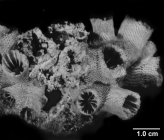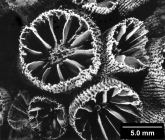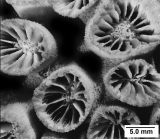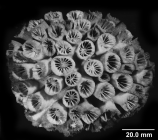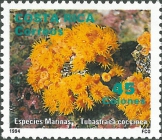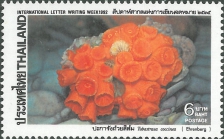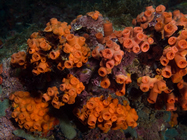
| Intro | | Search taxa | | Browse taxa | | Distributions | | Terminology | | References | | Statistics | | Online sources | | Tutorial | | Log in |
WRiMS taxon detailsTubastraea coccinea Lesson, 1830
291251 (urn:lsid:marinespecies.org:taxname:291251)
accepted
Species
marine,
Lesson, R.P. (1830). Voyage autour du monde : exécuté par ordre du roi, sur la corvette de Sa Majesté, la Coquille, pendant les années 1822, 1823, 1824, et 1825, par M. L.I. Duperrey. <em>Zoologie 2,.</em> Paris, 1826-1830. (vol. 2, pt 2, 2e division, 1830)., available online at https://www.biodiversitylibrary.org/page/38663489 [details]
Hoeksema, B. W.; Cairns, S. (2025). World List of Scleractinia. Tubastraea coccinea Lesson, 1830. Accessed through: Costello, M. J.; Ahyong, S.; Bieler, R.; Boudouresque, C.; Desiderato, A.; Downey, R.; Galil, B. S.; Gollasch, S.; Hutchings, P.; Kamburska, L.; Katsanevakis, S.; Kupriyanova, E.; Lejeusne, C.; Ma, K. C. K.; Marchini, A.; Occhipinti, A.; Pagad, S.; Pino, L.; Poore, G. C. B.; Rewicz, T.; Rius, M.; Robinson, T. B.; Sobczyk, R.; Stepien, A.; Turon, X.; Valls Domedel, G.; Verleye, T.; Vieira, L. M.; Willan, R. C.; Zhan, A. (2025) World Register of Introduced Marine Species (WRiMS) at: https://marinespecies.org/introduced/aphia.php?p=taxdetails&id=291251 on 2025-07-08
Costello, M. J.; Ahyong, S.; Bieler, R.; Boudouresque, C.; Desiderato, A.; Downey, R.; Galil, B. S.; Gollasch, S.; Hutchings, P.; Kamburska, L.; Katsanevakis, S.; Kupriyanova, E.; Lejeusne, C.; Ma, K. C. K.; Marchini, A.; Occhipinti, A.; Pagad, S.; Pino, L.; Poore, G. C. B.; Rewicz, T.; Rius, M.; Robinson, T. B.; Sobczyk, R.; Stępień, A.; Turon, X.; Valls Domedel, G.; Verleye, T.; Vieira, L. M.; Willan, R. C.; Zhan, A. (2025). World Register of Introduced Marine Species (WRiMS). Tubastraea coccinea Lesson, 1830. Accessed at: https://www.marinespecies.org/introduced/aphia.php?p=taxdetails&id=291251 on 2025-07-08
Date action by
original description
Lesson, R.P. (1830). Voyage autour du monde : exécuté par ordre du roi, sur la corvette de Sa Majesté, la Coquille, pendant les années 1822, 1823, 1824, et 1825, par M. L.I. Duperrey. <em>Zoologie 2,.</em> Paris, 1826-1830. (vol. 2, pt 2, 2e division, 1830)., available online at https://www.biodiversitylibrary.org/page/38663489 [details]
context source (Introduced species) Fofonoff, P.W.; Ruiz, G.M.; Steves, B.; Carlton, J.T. (2014-2024). National Exotic Marine and Estuarine Species Information System (NEMESIS). , available online at http://invasions.si.edu/nemesis [details] context source (HKRMS) Clark, T. H. (1997). The distribution of ahermatypic corals at cape d' Aguilar, Hong Kong. <em>In: Morton B, editor. Proceedings of the Eighth International Marine Biological Workshop: The Marine Flora and Fauna of Hong Kong and Southern China. Hong Kong University Press, Hong Kong.</em> 4: 219-233. [details] context source (Hexacorallia) Fautin, Daphne G. (2013). Hexacorallians of the World. (look up in IMIS) [details] basis of record Cairns, S.D., B.W. Hoeksema & J. van der Land. (2007). as a contribution to UNESCO-IOC Register of Marine Organisms. (look up in IMIS) [details] additional source Cairns, S.D., W.C. Jaap & J.C. Lang. (2009). Scleractinia (Cnidaria) of the Gulf of Mexico. <em>In: Felder DL. Camp DK (eds.) Gulf of Mexico–Origins, Waters, and Biota. Biodiversity. Texas A&M Press, College Station, Texas.</em> Pp. 333–347. [details] Available for editors additional source Cairns, S.D. (2009-2017). On line appendix: Phylogenetic list of the 711 valid Recent azooxanthellate scleractinian species with their junior synonyms and depth ranges, 28 pp. <em>In: Cold-Water Corals: The Biology and Geology of Deep-Sea Coral Habitats.</em> Cambridge University Press, Cambridge. [details] additional source Cairns, S.D. (1998). Azooxanthellate Scleractinia (Cnidaria: Anthozoa) of Western Australia. <em>Records of the Western Australian Museum.</em> 18(4): 361-417. [details] Available for editors additional source Cairns, S.D. (2004). The azooxanthellate Scleractinia (Coelenterata: Anthozoa) of Australia. <em>Records of the Australian Museum.</em> 56(3): 259-329. [details] Available for editors additional source Sammarco, P., S. Porter & S.D. Cairns. (2010). A new coral species introduced into the Atlantic Ocean - Tubastraea micranthus (Ehrenberg 1834) (Cnidaria, Anthozoa, Scleractinia): An invasive threat?. <em>Aquatic Invasions.</em> 5(2): 131-140., available online at https://doi.org/10.3391/ai.2010.5.2.02 [details] additional source Cairns, S.D., B.W. Hoeksema & J. van der Land. (1999). Appendix: List of extant stony corals. <em>Atoll Research Bulletin.</em> 459: 13-46. page(s): 27 [details] additional source Veron JEN. (1986). Corals of Australia and the Indo-Pacific. <em>Angus & Robertson Publishers.</em> page(s): 580, 584 [details] additional source Cairns, S.D. & N.B. Keller. (1993). New taxa and distributional records of azooxanthellate Scleractinia from the tropical south-west Indian Ocean, with comments on their zoogeography and ecology. <em>Annals of the South African Museum.</em> 103(5): 213-292, 13 pls. [details] Available for editors additional source Scheer G, Pillai CSG. (1974). Report on Scleractinia from the Nicobar Islands. <em>Zoologica, Stuttgart.</em> 42(122): 1-75. page(s): 10, 64-65, 75, plate 30 [details] additional source Cairns, S.D., L. Gershwin, F.J. Brook, P. Pugh, E.W. Dawson, O.V. Ocaña, W. Vervoort, G. Williams, J.E. Watson, D.M. Opresko, P. Schuchert, P.M. Hine, D.P. Gordon, H.I. Campbell, A.J. Wright, J.A.Sánchez & D.G. Fautin. (2009). Phylum Cnidaria: corals, medusae, hydroids, myxozoans. <em>in: Gordon, D.P. (Ed.) (2009). New Zealand inventory of biodiversity: 1. Kingdom Animalia: Radiata, Lophotrochozoa, Deuterostomia.</em> :59-101., available online at https://repository.si.edu/handle/10088/8431 [details] Available for editors additional source Creed, J. C. (2006). Two invasive alien azooxanthellate corals, Tubastraea coccinea and Tubastraea tagusensis, dominate the native zooxanthellate Mussismilia hispida in Brazil. <em>Coral Reefs.</em> 25(3): 350-350., available online at https://doi.org/10.1007/s00338-006-0105-x page(s): 350, Fig. 1b and c [details] additional source Fenner, D. (2001). Biogeography of three Caribbean corals (Scleractinia) and the invasion of Tubastraea coccinea into the Gulf of Mexico. <em>Bulletin of Marine Science.</em> 69: 1175-1189., available online at http://www.ingentaconnect.com/content/umrsmas/bullmar/2001/00000069/00000003/art00010?crawler=true page(s): 1175-1183 [details] Available for editors additional source Figueira de Paula, A.; Creed, J. C. (2004). Two species of the coral Tubastraea (Cnidaria, Scleractinia) in Brazil: a case of accidental introduction. <em>Bulletin of Marine Science.</em> 74: 175-183. page(s): 175-183 [details] additional source Kitahara, M.V., S.D. Cairns & D.J. Miller. (2010). Monophyletic origin of Caryophyllia (Scleractinia, Caryophylliidae), with descriptions of six new species. <em>Systematics and Biodiversity.</em> 8(1): 91-118., available online at https://doi.org/10.1080/14772000903571088 page(s): 115 [details] Available for editors additional source Lira, S.M.A., Farrapeira, C.M.R., Amaral, F.M.D. & Ramos, C.A.C. (2010). Sessile and sedentary macrofauna from the Pirapama shipwreck, Pernambuco, Brazil. <em>Biota Neotropica, 10(4), 155–166.</em> , available online at https://doi.org/10.1590/S1676-06032010000400021 page(s): 8 [details] additional source Reyes-Bonilla, H. (2002). Checklist of valid names and synonyms of stony corals (Anthozoa: Scleractinia) from the eastern Pacific. <em>Journal of Natural History.</em> 36(1): 1-13., available online at https://doi.org/10.1080/713833841 [details] additional source Arrigoni R, Kitano YF, Stolarski J, Hoeksema BW, Fukami H, Stefani F, Galli P, Montano S, Castoldi E, Benzoni F. (2014). A phylogeny reconstruction of the Dendrophylliidae (Cnidaria, Scleractinia) based on molecular and micromorphological criteria, and its ecological implications. <em>Zoologica Scripta.</em> 43 (6): 661-688., available online at https://doi.org/10.1111/zsc.12072 [details] additional source Reyes J, Santodomingo N, Flórez P. (2010). Corales Escleractinios de Colombia. <em>Instituto de Investigaciones Marinas y Costeras (INVEMAR), Santa Marta, Colombia.</em> pp 1-246. [details] additional source Tachikawa, H. (2005). Azooxanthellate Scleractinia (Hexacorallia, Anthozoa, Cnidaria) collected from Otsuki, Kochi prefecture, Japan. <em>Kuroshio Biosphere.</em> 2: 1-27. [details] additional source Song J-I. (1982). A study on the classification of the Korean Anthozoa 7. Scleractinia (Hexacorallia). <em>Korean Journal of Zoology.</em> 25 (3): 131-148. [details] additional source Kitahara MV. (2007). Species richness and distribution of azooxanthellate Scleractinia in Brazil. <em>Bulletin of Marine Science.</em> 81 (3): 497-518. [details] additional source Fenner, D. P. (2005). Corals of Hawai'i. A Field Guide to the Hard, Black, and Soft Corals of Hawai'i and the Northwest Hawaiian Islands, Including Midway. <em>Mutual Publishing, Ltd., Honolulu.</em> 144 pp. page(s): 26, 82 [details] additional source Song J-I. (1988). A systematic study on the Korean Anthozoa 11.Cnidae of Scleractinia. <em>Korean Journal of Systematic Zoology.</em> Special Issue 2: 26-36. [details] additional source Song J-I. (1991). A systematic study on the Korean Anthozoa 12. Order Scleractinia. <em>Korean Journal of Systematic Zoology.</em> 7 (1): 127-150, pls. 1-3. [details] additional source Choi E, Song J-I. (2017). Three records of the genus Tubastraea (Anthozoa:Hexacorallia: Scleractinia: Dendrophylliidae) from Korea. <em>Animal Systematics, Evolution and Diversity.</em> 33(2): 65-72. [details] additional source Pires DE. (2007). The azooxanthellate coral fauna of Brazil. <em>Bulletin of Marine Science.</em> 81:265-272. [details] additional source Santodomingo, N.; Reyes, J.; Flórez, P.; Chacón-Gómez, I.C.; van Ofwegen, L.P.; Hoeksema, B.W. (2012). Diversity and distribution of azooxanthellate corals in the Colombian Caribbean. <em>Marine Biodiversity.</em> 43(1): 7-22., available online at https://doi.org/10.1007/s12526-012-0131-6 [details] additional source Kitahara, M.V. & S.D. Cairns. (2021). Azooxanthellate Scleractinia (Cnidaria, Anthozoa) from New Caledonia. <em>Mémoires du Muséum national d'Histoire naturelle.</em> 215:1-722. [details] Available for editors additional source Maragos, J. E.; Siciliano, D.; Gulko, D.; VanRavenswaay, D.; Potts, D. C.; Aeby, G. (2004). Nihoa Island coral data compiled from Townsend Cromwell 2000, and Rapture 2000 and 2002 sites [Table 1]. Unpublished. [details] additional source Zlatarski, V. N.; Estalella, N. M. (1980). Scleractinia of Cuba with data on the constituent organisms [in Bulgarian]. Bulgarian Academy of Science. Sophia., pp. 312. page(s): 18, 23, 24, 185, 187-190, 224-227, 244, 247-249, 250, 299, 311 [details] additional source Maragos, J. E.; Molina, M.; Kenyon, J. (2004). Palmyra Atoll coral data compiled from Townsend Cromwell 2000-2002, U.S. Fish and Wildlife Service 2000-2001, and Sette 2004 surveys [Table 8]. UNPUBLISHED, UNPUBLISHED [details] additional source Maragos, J. E.; Gulko, D.; Aeby, G.; Potts, D. C. (2004). Gardner Pinnacles 2000-3 coral data compiled from Rapture 2000 and 2002, and Sette 2003 sites [Table 2]. UNPUBLISHED, Unpublished page(s): 1 [details] additional source Maragos, J. E.; Schmerfeld, J. (2004). Coral survey from Howland Island National Wildlife Refuge, 1998-2004 [Table 3]. UNPUBLISHED, Unpublished page(s): 1 [details] additional source Maragos, J. E.; VanRavenswaay, D.; Gulko, D. (2004). French Frigate Shoals coral data compiled from Townsend Cromwell 2000-2, US Fish and Wildlife Service, Rapture 2000 and 2002, and 2003 Sette surveys [Table 1]. UNPUBLISHED, Unpublished page(s): 1 [details] additional source Maragos, J. E.; Siciliano, D.; VanRavenswaay, D.; Aeby, G.; Kenyon, J.; Gulko, D.; Potts, D. C. (2004). Maro reef coral data compiled from Townsend Cromwell 2000 and 2002, American Islander 2001, Rapture 2000 and 2002, and Sette 2003 surveys [Table 9]. UNPUBLISHED, Unpublished page(s): 1 [details] additional source Maragos, J. E.; Siciliano, D.; VanRavenswaay, D.; Gulko, D.; Aeby, G.; Kenyon, J.; Kenyon, J.; Potts, D. C. (2004). Pearl & Hermes Atoll coral data compiled from Rapture & Townsend Cromwell 2000 and 2002, American Islander 2001, and Sette 2003 surveys [Table 13]. UNPUBLISHED, Unpublished page(s): 1 [details] additional source Maragos, J. E.; Kenyon, J.; Dana, T.; Aeby, G.; Siciliano, D.; VanRavenswaay, D.; Gulko, D.; Potts, D. C. (2004). Midway Atoll coral data compiled from Rapture 2000 and 2002, Townsend Cromwell 2002, US Fish and Wildlife Service 2000, and Sette 2003 surveys [Table 14]. UNPUBLISHED, Unpublished [details] additional source Maragos, J. E.; Potts, D. C.; Aeby, G.; Gulko, D.; Kenyon, J.; Siciliano, D.; VanRavenswaay, D. (2004). 2000-2002 rapid ecological assessment of coral (Anthozoa) on shallow reefs of the Northwestern Hawaiian Islands. Part 1: Species and distribution. Pacific Science, 58(2): 211-230 page(s): 217 [details] additional source Maragos, J. E.; VanRavenswaay, D.; Aeby, G.; Gulko, D.; Kenyon, J.; Siciliano, D.; Potts, D. C. (2004). Kure Atoll coral data compiled from Rapture and Townsend Cromwell 2000 and 2002, and Sette 2003 surveys [Table 15]. UNPUBLISHED, Unpublished page(s): 1 [details] additional source Maragos, J. E. (2004). Baker Island coral data [Table unnumbered]. UNPUBLISHED, Unpublished page(s): 2 [details] additional source Song, J. I. (2000). Cnidaria 2: Anthozoa. Korea Institute of Bioscience and Biotechnology., volume 5, pp. 332. page(s): 286-288 [details] additional source DeFelice, R.; Minton, D.; Godwin, L. S. (2002). Records of Shallow-Water Marine Invertebrates from French Frigate Shoals, Northwestern Hawaiian Islands, with a Note on Noningenous Species: Report to U.S. Fish & Wildlife Service. Bishop Museum. Honolulu, Hawaii., pp. 78. page(s): 26, 51 [details] additional source Maragos, J. E. (1977). Order Scleractinia, Stony Corals. Dennis M. Devaney and Lucius G. Eldredge (eds.). Bishop Museum Press. Honolulu, Hawaii, pp. 84 page(s): 162, 197, 199-200 [details] additional source Serra, S., Bastos, N., Coutinho, R., Schizas, N.V., Johnsson, R., Neves, E. (2024). Four new species of Tubastraea (Scleractinia, Dendrophylliidae) from the Brazilian Coast, Southwestern Atlantic. <em>Pan-American Journal of Aquatic Sciences.</em> 19(2): 113-135., available online at http://panamjas.org/pdf_artigos/PANAMJAS_19(2)_113-135.pdf [details] Available for editors redescription Cairns, S. D. (1991). A Revision of the Ahermatypic Scleractinia of the Galapagos and Cocos Islands. Smithsonian Contributions to Zoology, 504; 44 pp. [details] Available for editors redescription Cairns, S.D. (2000). A revision of the shallow-water azooxanthellate Scleractinia of the western Atlantic. <em>Studies on the Natural History of the Caribbean Region.</em> 75: 1-231. [details] Available for editors redescription Cairns, S.D. (1994). Scleractinia of the temperate North Pacific. <em>Smithsonian Contributions to Zoology.</em> 557: 1-150. [details] Available for editors redescription Cairns, S.D. & H. Zibrowius. (1997). Cnidaria Anthozoa: Azooxanthellate Scleractinia from the Philippine and Indonesian regions. <em>in: Crosnier, A. et al. (Ed.) Résultats des Campagnes MUSORSTOM 16. Campagne Franco-Indonésienne KARUBAR. Mémoires du Muséum national d'Histoire naturelle. Série A, Zoologie.</em> 172: 27-244. (look up in IMIS) [details] Available for editors  Present Present  Inaccurate Inaccurate  Introduced: alien Introduced: alien  Containing type locality Containing type locality
From regional or thematic species database
Introduced species impact Brazilian part of the South Atlantic Ocean (Marine Region): Alters trophic interactions [details]Introduced species impact Brazilian part of the South Atlantic Ocean (Marine Region): Outcompetes native species for resources and/or space [details] Introduced species impact in Gulf of Mexico (IHO Sea Area) : Alters trophic interactions [details] Introduced species impact in Gulf of Mexico (IHO Sea Area) : Outcompetes native species for resources and/or space [details] Introduced species impact Brazilian part of the South Atlantic Ocean (Marine Region) Overall, results suggest a negative tipping point between partial to nearly full coral cover, especially at sites where physically complex macroalgae, capable to retain sediments and hence the invertebrates therein, are displaced by the establishment and growth of sun-coral colonies. As important prey for reef fishes, the collapse of small crustacean populations may alter whole-reef ecosystem functioning and negatively impact local fisheries. [details] Introduced species impact Brazilian part of the South Atlantic Ocean (Marine Region) Alters trophic interactions [details] Introduced species impact in Brazilian part of the South Atlantic Ocean (Marine Region) : Adverse habitat modification [details] Introduced species management Brazilian part of the South Atlantic Ocean (Marine Region) We conclude that Vinegar/acetic acid (V/AA) is an effective agent for killing Tubastraea spp. and most other aquatic organisms, can be applied using different methods and in different environments for controlling: (1) invasive or outbreak species; and (2) biofouling by native or invasive species on aquaculture systems and vectors. V/AA may be used applied pre-border to shipping vectors potentially transporting non-indigenous marine biofouling species such as Tubastraea spp. [details] Introduced species remark Brazilian part of the South Atlantic Ocean (Marine Region): A number of impacts have been studied in Brazilian waters, including: competition and overgrowth of native corals (Creed 2006; Silva et al. 2011); how settlement affects food webs by replacing hermatypic corals (containing symbiotic algae, relying partly on photosynthesis for nutrition) with corals which are exclusively carnivorous (Silva et al. 2011); and the inhibition of feeding by coral reef fishes (Lages et al. 2011). [details] Introduced species remark In Gulf of Mexico (IHO Sea Area) : In US waters, it has largely been confined to artificial substrates such as oil platforms, shipwrecks, and artificial reefs, but its spread to coral reefs is a concern, particularly in the Flower Garden Banks National Marine Sanctuary in the Northwestern Gulf of Mexico. This species may compete with and overgrow native corals, potentially affecting food webs and altering the feeding habits of reef fish. [details] Introduced species vector dispersal in Gulf of Guinea (IHO Sea Area) : Hull fouling has probably been the major vector of transport between distant ocean regions, but the larvae can remain competent for 100 days, permitting regional dispersal by currents (Fenner 2001). Disposal by aquarists is a potential vector for future invasions (Shearer 2011). [details] Introduced species vector dispersal in Gulf of Mexico (IHO Sea Area) : Potential for spread via oil tanker fouling communities. [details] Introduced species vector dispersal in Mexico (Nation) : Potential for spread via oil tanker fouling communities. [details] Introduced species vector dispersal in Gulf of Mexico (IHO Sea Area) : Potential for spread via oil tanker fouling communities. [details] Introduced species vector dispersal in Mexico (Nation) : Potential for spread via oil tanker fouling communities. [details] Introduced species vector dispersal in Belizean part of the Caribbean Sea : Hull fouling has probably been the major vector of transport between distant ocean regions, but the larvae can remain competent for 100 days, permitting regional dispersal by currents (Fenner 2001). Disposal by aquarists is a potential vector for future invasions (Shearer 2011). [details] Introduced species vector dispersal Brazilian part of the South Atlantic Ocean (Marine Region): Hull fouling has probably been the major vector of transport between distant ocean regions, but the larvae can remain competent for 100 days, permitting regional dispersal by currents (Fenner 2001). Disposal by aquarists is a potential vector for future invasions (Shearer 2011). [details] Introduced species vector dispersal in Cape Verdean part of the North Atlantic Ocean : Hull fouling has probably been the major vector of transport between distant ocean regions, but the larvae can remain competent for 100 days, permitting regional dispersal by currents (Fenner 2001). Disposal by aquarists is a potential vector for future invasions (Shearer 2011). [details] Introduced species vector dispersal in Caribbean Sea (IHO Sea Area) : Hull fouling has probably been the major vector of transport between distant ocean regions, but the larvae can remain competent for 100 days, permitting regional dispersal by currents (Fenner 2001). Disposal by aquarists is a potential vector for future invasions (Shearer 2011). [details] Introduced species vector dispersal in Gulf of Mexico (IHO Sea Area) : Hull fouling has probably been the major vector of transport between distant ocean regions, but the larvae can remain competent for 100 days, permitting regional dispersal by currents (Fenner 2001). Disposal by aquarists is a potential vector for future i [details] Introduced species vector dispersal in Gulf of Mexico (IHO Sea Area) : Hull fouling has probably been the major vector of transport between distant ocean regions, but the larvae can remain competent for 100 days, permitting regional dispersal by currents (Fenner 2001). Disposal by aquarists is a potential vector for future invasions (Shearer 2011). [details] Introduced species vector dispersal in Jamaican part of the Caribbean Sea : Hull fouling has probably been the major vector of transport between distant ocean regions, but the larvae can remain competent for 100 days, permitting regional dispersal by currents (Fenner 2001). Disposal by aquarists is a potential vector for future invasions (Shearer 2011). [details] Introduced species vector dispersal Galapagos part of the South Pacific Ocean (Marine Region) Ships: accidental as attached or free-living fouling organisms [details] Introduced species vector dispersal in Brazilian part of the South Atlantic Ocean (Marine Region) : Natural dispersal [details]
To Barcode of Life (38 barcodes)
To Biodiversity Heritage Library (20 publications) To Biological Information System for Marine Life (BISMaL) To Digital Atlas Of Marine Species & Locations, DAMSL (orange cup coral) To Digital Atlas Of Marine Species & Locations, DAMSL (Tubastraea coral polyp) To European Nucleotide Archive, ENA (Tubastraea coccinea) To Global Biotic Interactions (GloBI) To Global Invasive Species Database (GISD) To USNM Invertebrate Zoology Cnidaria Collection (147 records) To ITIS |
